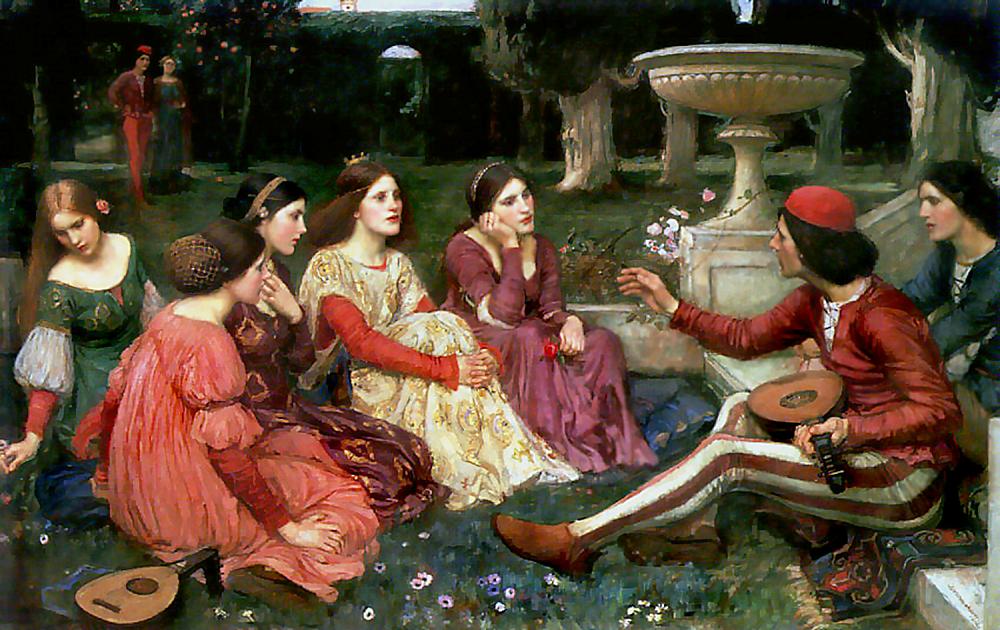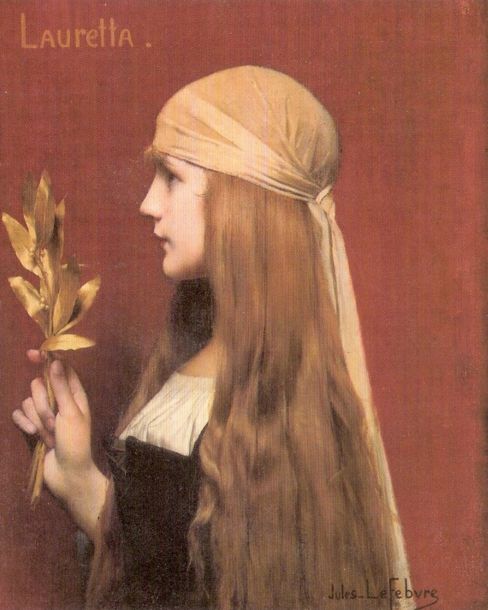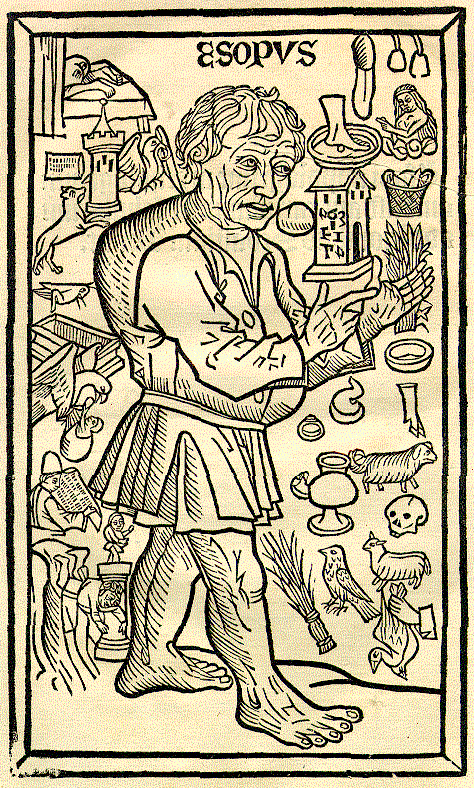|
Fabliau
A ''fabliau'' (; plural ''fabliaux'') is a comic, often anonymous tale written by jongleurs and clerics in France between c. 1150 and 1400. They are generally characterized by sexual and scatological obscenity, and by a set of contrary attitudes generally critical or mocking of the church and nobility. While most fabliaux were anonymous, we do know some authors like Jean Bodel or Guèrin, who wrote during the peak of the genre's popularity. Several of them were reworked by Giovanni Boccaccio for the '' Decameron'' and by Geoffrey Chaucer for ''The Canterbury Tales''. Some 150 French ''fabliaux'' are extant, the number depending on how narrowly ''fabliau'' is defined. According to R. Howard Bloch, ''fabliaux'' are the first expression of literary realism in Europe. Some nineteenth-century scholars, most notably Gaston Paris, argue that ''fabliaux'' originally came from the Orient and were brought to the West by returning crusaders. Context The time that the fabliaux were most ... [...More Info...] [...Related Items...] OR: [Wikipedia] [Google] [Baidu] |
Richeut
Richeut is the earliest known fabliau, dating from 1159. The only known manuscrit of the fabliau is preserved at the Burgerbibliothek of Berne under the classification number 354, f. 124va-135va. Although ''Richeut'' shares many of the same characteristics as other fabliaux, it has several unique features: 1. It mentions the outcome of a sexual encounter. 2. It breaks the taboo of incest. 3. It is unusually long, containing 1019 lines. 4. It does not use octosyllables, but a tailrhyme strophe. 5. It has character development. 6. The characters of Richeut and Herselot, the maid, exist outside of this text. Summary This tale recounts the life of a prostitute who uses men to her advantage. She does not discriminate between classes, for she dupes a nobleman, a bourgeois and a clergyman into believing that they are the father of her son, whom she conceived on purpose because she felt that they were no longer paying her enough attention. All three men lavish her and her so ... [...More Info...] [...Related Items...] OR: [Wikipedia] [Google] [Baidu] |
Jean Bodel
Jean Bodel (c. 1165 – c. 1210), also spelled Jehan Bodel, was an Old French -4; we might wonder whether there's a point at which it's appropriate to talk of the beginnings of French, that is, when it wa ... poet who wrote a number of '' chanson de geste">chansons de geste'' as well as many fabliaux. He lived in Arras">fabliaux.html" ;"title="chanson de geste">chansons de geste'' as well as many fabliaux">chanson de geste">chansons de geste'' as well as many fabliaux. He lived in Arras. Writings Bodel wrote ("Song of the Saxons") about the war of King Charlemagne with the Saxon people, Saxons and their leader Widukind, whom Bodel calls ''Guiteclin''. He also wrote a miracle play called the '':fr:Le Jeu de saint Nicolas, Le Jeu de saint Nicolas'' ("The Play of Saint Nicolas"), which was probably first performed in Arras on 5 December 1200. Set in the middle of an epic battle between Christians and Muslims, the play tells the story of a good Christian who escapes the battle and ... [...More Info...] [...Related Items...] OR: [Wikipedia] [Google] [Baidu] |
Novel
A novel is an extended work of narrative fiction usually written in prose and published as a book. The word derives from the for 'new', 'news', or 'short story (of something new)', itself from the , a singular noun use of the neuter plural of ''novellus'', diminutive of ''novus'', meaning 'new'. According to Margaret Doody, the novel has "a continuous and comprehensive history of about two thousand years", with its origins in the Ancient Greek and Roman novel, Medieval Chivalric romance, and the tradition of the Italian Renaissance novella.Margaret Anne Doody''The True Story of the Novel'' New Brunswick, NJ: Rutgers University Press, 1996, rept. 1997, p. 1. Retrieved 25 April 2014. The ancient romance form was revived by Romanticism, in the historical romances of Walter Scott and the Gothic novel. Some novelists, including Nathaniel Hawthorne, Herman Melville, Ann Radcliffe, and John Cowper Powys, preferred the term ''romance''. Such romances should not be con ... [...More Info...] [...Related Items...] OR: [Wikipedia] [Google] [Baidu] |
The Canterbury Tales
''The Canterbury Tales'' () is a collection of 24 stories written in Middle English by Geoffrey Chaucer between 1387 and 1400. The book presents the tales, which are mostly written in verse, as part of a fictional storytelling contest held by a group of pilgrims travelling together from London to Canterbury to visit the shrine of Saint Thomas Becket at Canterbury Cathedral. The ''Tales'' are widely regarded as Chaucer's '' magnum opus''. They had a major effect upon English literature and may have been responsible for the popularisation of the English vernacular in mainstream literature, as opposed to French or Latin. English had, however, been used as a literary language centuries before Chaucer's time, and several of Chaucer's contemporaries— John Gower, William Langland, the Gawain Poet, and Julian of Norwich—also wrote major literary works in English. It is unclear to what extent Chaucer was seminal in this evolution of literary preference. ''The Canterbury Tale ... [...More Info...] [...Related Items...] OR: [Wikipedia] [Google] [Baidu] |
Rutebeuf
Rutebeuf (or Rustebeuf) (fl. 1245 – 1285) was a French trouvère (poet-composers who worked in France's northern dialects). Early life He was born in the first half of the 13th century, possibly in Champagne (he describes conflicts in Troyes in 1249); he was evidently of humble birth, and was a Parisian by education and residence. Career His name is not mentioned by his contemporaries. He frequently plays in his verse on the word ''Rutebeuf'', which was a pen name, and is variously explained by him as derived from ''rude boeuf'' and ''rude oeuvre'' ("coarse ox" or "rustic piece of work"). Paulin Paris thought that he began life in the lowest rank of the minstrel profession as a ''jongleur'' (juggler and musician). Some of his poems have autobiographical value. In ''Le Mariage de Rutebeuf'' ("The Marriage of Rutebeuf") he writes that on 2 January 1261 he married a woman old and ugly, with neither dowry nor amiability. In the ''Complainte de Rutebeuf'' he details a series of ... [...More Info...] [...Related Items...] OR: [Wikipedia] [Google] [Baidu] |
Decameron
''The Decameron'' (; or ''Decamerone'' ), subtitled ''Prince Galehaut'' (Old ) and sometimes nicknamed ''l'Umana commedia'' ("the Human comedy", as it was Boccaccio that dubbed Dante Alighieri's ''Comedy'' "''Divine''"), is a collection of short stories by the 14th-century Italian author Giovanni Boccaccio (1313–1375). The book is structured as a frame story containing 100 tales told by a group of seven young women and three young men; they shelter in a secluded villa just outside Florence in order to escape the Black Death, which was afflicting the city. The epidemic is likely what Boccaccio used for the basis of the book which was thought to be written between 1348–1353. The various tales of love in ''The Decameron'' range from the erotic to the tragic. Tales of wit, practical jokes, and life lessons also contribute to the mosaic. In addition to its literary value and widespread influence (for example on Chaucer's ''Canterbury Tales''), it provides a document of lif ... [...More Info...] [...Related Items...] OR: [Wikipedia] [Google] [Baidu] |
Canterbury Tales
''The Canterbury Tales'' () is a collection of 24 stories written in Middle English by Geoffrey Chaucer between 1387 and 1400. The book presents the tales, which are mostly written in verse (poetry), verse, as part of a fictional storytelling contest held by a group of pilgrims travelling together from London to Canterbury to visit the shrine of Saint Thomas Becket at Canterbury Cathedral. The ''Tales'' are widely regarded as Chaucer's ''Masterpiece, magnum opus''. They had a major effect upon English literature and may have been responsible for the popularisation of the English vernacular in mainstream literature, as opposed to French language, French or Latin. English had, however, been used as a literary language centuries before Chaucer's time, and several of Chaucer's contemporaries—John Gower, William Langland, the Gawain Poet, and Julian of Norwich—also wrote major literary works in English. It is unclear to what extent Chaucer was seminal in this evolution of lite ... [...More Info...] [...Related Items...] OR: [Wikipedia] [Google] [Baidu] |
Parable
A parable is a succinct, didactic story, in prose or verse, that illustrates one or more instructive lessons or principles. It differs from a fable in that fables employ animals, plants, inanimate objects, or forces of nature as characters, whereas parables have human characters. A parable is a type of metaphorical analogy. Some scholars of the canonical gospels and the New Testament apply the term "parable" only to the parables of Jesus, although that is not a common restriction of the term. Etymology The word ''parable'' comes from the Greek παραβολή (''parabolē''), literally "throwing" (''bolē'') "alongside" (''para-''), by extension meaning "comparison, illustration, analogy." It was the name given by Greek rhetoricians to an illustration in the form of a brief fictional narrative. History The Bible contains numerous parables in the Gospels of the New Testament ( Jesus' parables). These are believed by some scholars (such as John P. Meier) to have been inspir ... [...More Info...] [...Related Items...] OR: [Wikipedia] [Google] [Baidu] |
Fables From La Fountaine
Fable is a literary genre defined as a succinct fictional story, in prose or verse, that features animals, legendary creatures, plants, inanimate objects, or forces of nature that are anthropomorphized, and that illustrates or leads to a particular moral lesson (a "moral"), which may at the end be added explicitly as a concise maxim or saying. A fable differs from a parable in that the latter ''excludes'' animals, plants, inanimate objects, and forces of nature as actors that assume speech or other powers of humankind. Conversely, an animal tale specifically includes talking animals as characters. Usage has not always been so clearly distinguished. In the King James Version of the New Testament, "" ("''mythos''") was rendered by the translators as "fable" in the First Epistle to Timothy, the Second Epistle to Timothy, the Epistle to Titus and the First Epistle of Peter. A person who writes fables is referred to as a fabulist. Global history The fable is one of the most endurin ... [...More Info...] [...Related Items...] OR: [Wikipedia] [Google] [Baidu] |
Prose
Prose is language that follows the natural flow or rhythm of speech, ordinary grammatical structures, or, in writing, typical conventions and formatting. Thus, prose ranges from informal speaking to formal academic writing. Prose differs most notably from poetry, which follows some type of intentional, contrived, artistic structure. Poetic structures vary dramatically by language; in English poetry, language is often organized by a rhythmic metre and a rhyme scheme. The ordinary language of a region or community and many other forms and styles of language fall under prose, a label that can describe both speech and writing. In writing, prose is visually formatted differently than poetry. Poetry is traditionally written in verse: a series of lines on a page, parallel to the way that a person would highlight the structure orally if saying the poem aloud; for example, poetry may end with a rhyme at the end of each line, making the entire work more melodious or memorable. Pro ... [...More Info...] [...Related Items...] OR: [Wikipedia] [Google] [Baidu] |
Aesop
Aesop ( ; , ; c. 620–564 BCE; formerly rendered as Æsop) was a Greeks, Greek wikt:fabulist, fabulist and Oral storytelling, storyteller credited with a number of fables now collectively known as ''Aesop's Fables''. Although his existence remains unclear and no writings by him survive, numerous tales credited to him were gathered across the centuries and in many languages in a storytelling tradition that continues to this day. Many of the tales associated with him are characterized by anthropomorphic animal characters. Scattered details of Aesop's life can be found in ancient sources, including Aristotle, Herodotus, and Plutarch. An ancient literary work called ''The Aesop Romance'' tells an episodic, probably highly fictional version of his life, including the traditional description of him as a strikingly ugly Slavery in Ancient Greece, slave () who by his cleverness acquires freedom and becomes an adviser to kings and city-states. Older spellings of his name have included ... [...More Info...] [...Related Items...] OR: [Wikipedia] [Google] [Baidu] |







